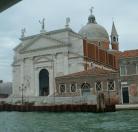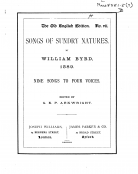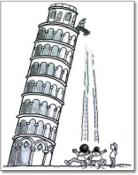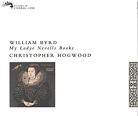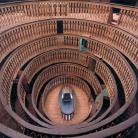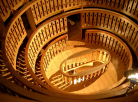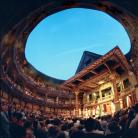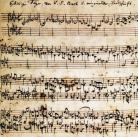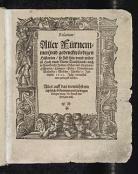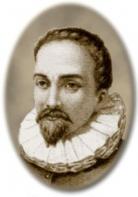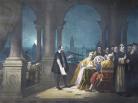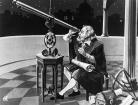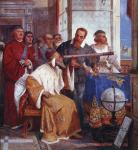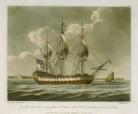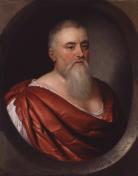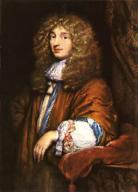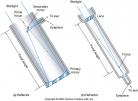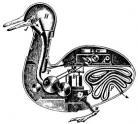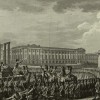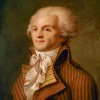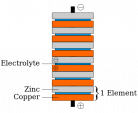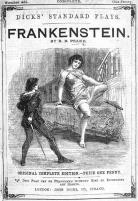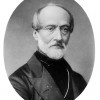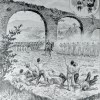Making the Human/ Inventing Venice
Created by Dino Franco Felluga on Fri, 12/30/2016 - 10:56
Part of Group:
This timeline allows students to see important events connected to the transition from Medieval to Renaissance Italy (focussed especially on Venice).
Timeline
Chronological table
| Date | Event | Created by | Associated Places | |
|---|---|---|---|---|
| 1566 to 1600 |
Life of Antonio ContinFollowing in the footsteps of his uncle, Antonio da Ponte, Antonio Contin was an architect in Venice. The only work he is well-known for is the Bridge of Sighs, which connects the Doge's Palace to the New Prison. Although he designed the bridge, he did not live long enough to see it finished; it was completed 2 years after his death. Much of his other work was with his uncle. He assisted with rebuilding the Rialto Bridge his uncle designed, and he took over the New Prison project after his uncle's death. |
Teresa Ortyl | ||
| 1567 |
Villa Capra "La Rotonda"Villa Capra “La Rotonda” is one of the most recognizable buildings from the Renaissance. Construction started in 1567 on the project and was designed by Palladio. During construction, Palladio died and Vincenzo Scamozzi took over the project. Neither Palladio nor Paolo Almerico, the owner, were present for the physical construction of the building. The villa was designed to be located in the suburbs, however, it is now a country farm. The building is a square and each side has its own façade. Palladio originally intended for the roof to be dome-shaped, but it was finished with smaller dome topped with a cupola. This information is from architectuul.com. The photo is from Wikimedia Commons and is free to share. |
Nathaniel Gollmer | ||
| 1570 |
I quattro libri dell'architettura publishedTranslating to "The Four Books of Architecture", this work by Palladio is a set of nine rules on architecture from walls to details. This work was published in Venice in 1570. The designs mix Roman influence with the new ways of thinking from the renaissance. Widely disseminated, this book influenced architectural design for years to come. This information comes from http://architectura.cesr.univ-tours.fr/traite/Notice/ENSBA_LES1338.asp?p.... The image is taken from Wikimedia commons, from Sailko. |
Tim Brunner | ||
| 1571 |
The Introduction of the Galleass into the Venetian Fleet:The Galleass, also called galeazze, was a naval ship first used in 1571 against the Ottoman Empire in the Battle of Lepatano. The Galleass’s shape and design comes from earlier Venetian ships called galea grossa. The galea grossa, which in English means great galley, according to an academic paper from High Point University written by Andrew Tzavaras, is better than the smaller, commonplace galley because the "standard galleys lacked cargo holds, devoting most of their decks to the oarsmen, great galleys offered a balance between speed, space, and security.” The Galleass is similar to the galea grossa except that the Galleass is much larger and takes advantage of gunpowder. The Galleass became one of the very first naval ships to implement cannons and explosives. As a result, the Galleass was very dominant in the Mediterranean and was successful at keeping the Ottoman Empire at bay with its impressive bombardment during the late 1500s. After defeating the Ottomans at battle, fame of the galleass spread throughout Europe. Lastly, The Galleass served as the basis for later ship models such as the frigate. Source: Tzavarus, A. (n.d.). The Galleasses at Lepanto as a Reflection of the Sixteenth-Century Venetian Strategic Outlook [Scholarly project]. Retrieved from gjh.ojs.chass.ncsu.edu/index.php/Graduate/article/download/13/pdf_7 This picture is public domain because the picture is from A History of Naval Architecture which was published in 1851. |
Jacob Hussey | ||
| 1572 |
Saint Bartholomew's MassacreHaving taken place in 1572, the Saint Barholomew's Day massacre was a targeted group of assassinations that was then followed by a bout of Roman Catholic mob violence. The massacre began two days after the attempted assassination of Admiral Gaspard de Coligny who was a political and military leader of the Huguenots. The mob violence that ensued after the original massacre was also aimed at the Huguenots. Catherine de' Medici is thought of as the person who initiated the massacre to begin with. |
Mara Kossoff | ||
| 1576 to 1591 |
Il RedentoreTranslating to "the Redeemer", this church by Palladio was built in order to offer thanks for those that survived the plague of 1575. This church was built in the Palladian style, reflecting Roman influence. Each year in July, there is a festival (The Festa del Redentore) that culminates in the Doge attending mass at Il Redentore. This information was taken from http://www.greatbuildings.com/buildings/Redentore_Church.html. The image is from CC BY-SA 3.0, https://commons.wikimedia.org/w/index.php?curid=20826 |
Tim Brunner | ||
| 20 Dec 1577 |
The 1577 Fire in the Doge's Palace:On December 20, 1577, a devestating fire swept through the Doge's palace, destroying much of the southern part of the building. The Great Council Chamber and artwork made by notable artists of the day were among the things damaged in the fire. When rebuilding the Doge's palace after the damages, the original gothic design of the building was kept, although some neoclassical elements were incorporated into it. Because there was minimal structural damage due to the fire, the reconstruction was finished by 1580. The picture is by Radomil (Own work) [GFDL (http://www.gnu.org/copyleft/fdl.html), CC-BY-SA-3.0 .(http://creativecommons.org/licenses/by-sa/3.0/) or CC BY 2.5 (http://creativecommons.org/licenses/by/2.5)], via Wikimedia Commons. It is free to copy and redistribute. |
Teresa Ortyl | ||
| 1589 |
Songs of Sundrie Natures:This is one of William Byrd's most famous compositions. This along with a collection he released a year earlier called Psalms, Sonnets and Songs of Sadness and Pietie are both recognized to have extremely impressive use of vocal parallels, which Byrd synced with the instruments. This is also notable because it is a secular volume, but was dedicated to a Catholic. This was to show his loyalty to the Crown, while also keeping true to his beliefs. Image source: imslp.org |
Justin Chan | ||
| 1589 |
Galileo published Du Motu (On Motion)an analysis of falling objects that departed from the traditional Aristolian views. At this time, he was teaching at the University of Pisa. Here he conducted his famed experiments on falling objects. It is said that he demonstrated these bold ideas by dropping two cannonballs of different weights off of the leaning tower of Pisa, showing that they accelerated at the same rate. |
Kai Strubel | ||
| 11 Sep 1591 |
My Ladye Nevells Booke:This is a manuscript created by William Byrd, and is often considered one of the most important Renaissance keyboard collections. It was put together as his 42 best works for keyboard, with some notable pieces including The Passinge Mesures Pavian and Galliarde and Have with yow to Walsingame. It was often said that these compositions were an incredible inspiration to Johann Bach and Beethoven, and that this collection is one of the first to really leave an impact on Western music. It is also fascinating because these pieces show a transition of style. The earlier music shows his polyphonic counterpoint style, but then transitions to the demanding, energetic, rhythmically intensive pieces of his later pieces. Image source: Amazon |
Justin Chan | ||
| 1594 to 1872 |
The University of Padova’s Anatomical TheaterConstructed in 1594 by Girolamo Fabricius Acquapendente, the anatomical theater at the University of Padova’s Palazzo del Bo is the oldest surviving anatomical theater in the world. The theater has an elliptical shape and has six tiers carved from walnut, with enough room for 300 guests. The tiers are designed so every student would have an uncompromised view of the dissection table, which is still in place. Andreas Vesalius practiced in this anatomical theater and dissections were performed until 1872. An original inscription can still be seen today, which reads, Hic locus est ubi mors gaudet succurrere vitae (This is a place where the dead are pleased to help the living). Sources: http://www.italymagazine.com/featured-story/italys-ancient-medical-schools-anatomical-theatres & http://www.atlasobscura.com/places/palazzo-del-bo Image source: http://www.nature.com/nature/journal/v454/n7205/images/454699a-i1.0.jpg and it is public domain. |
Kate Harris | ||
| 1595 |
Padova Anatomical Theater96 Normal 0 false false false EN-US X-NONE X-NONE DefSemiHidden="false" DefQFormat="false" DefPriority="99" LatentStyleCount="380"> UnhideWhenUsed="true" QFormat="true" Name="heading 2"/> UnhideWhenUsed="true" QFormat="true" Name="heading 3"/> UnhideWhenUsed="true" QFormat="true" Name="heading 4"/> UnhideWhenUsed="true" QFormat="true" Name="heading 5"/> UnhideWhenUsed="true" QFormat="true" Name="heading 6"/> UnhideWhenUsed="true" QFormat="true" Name="heading 7"/> UnhideWhenUsed="true" QFormat="true" Name="heading 8"/> UnhideWhenUsed="true" QFormat="true" Name="heading 9"/> Name="index 1"/> Name="index 2"/> Name="index 3"/> Name="index 4"/> Name="index 5"/> Name="index 6"/> Name="index 7"/> Name="index 8"/> Name="index 9"/> UnhideWhenUsed="true" Name="toc 1"/> UnhideWhenUsed="true" Name="toc 2"/> UnhideWhenUsed="true" Name="toc 3"/> UnhideWhenUsed="true" Name="toc 4"/> UnhideWhenUsed="true" Name="toc 5"/> UnhideWhenUsed="true" Name="toc 6"/> UnhideWhenUsed="true" Name="toc 7"/> UnhideWhenUsed="true" Name="toc 8"/> UnhideWhenUsed="true" Name="toc 9"/> Name="Normal Indent"/> Name="footnote text"/> Name="annotation text"/> Name="header"/> Name="footer"/> Name="index heading"/> UnhideWhenUsed="true" QFormat="true" Name="caption"/> Name="table of figures"/> Name="envelope address"/> Name="envelope return"/> Name="footnote reference"/> Name="annotation reference"/> Name="line number"/> Name="page number"/> Name="endnote reference"/> Name="endnote text"/> Name="table of authorities"/> Name="macro"/> Name="toa heading"/> Name="List"/> Name="List Bullet"/> Name="List Number"/> Name="List 2"/> Name="List 3"/> Name="List 4"/> Name="List 5"/> Name="List Bullet 2"/> Name="List Bullet 3"/> Name="List Bullet 4"/> Name="List Bullet 5"/> Name="List Number 2"/> Name="List Number 3"/> Name="List Number 4"/> Name="List Number 5"/> Name="Closing"/> Name="Signature"/> UnhideWhenUsed="true" Name="Default Paragraph Font"/> Name="Body Text"/> Name="Body Text Indent"/> Name="List Continue"/> Name="List Continue 2"/> Name="List Continue 3"/> Name="List Continue 4"/> Name="List Continue 5"/> Name="Message Header"/> Name="Salutation"/> Name="Date"/> Name="Body Text First Indent"/> Name="Body Text First Indent 2"/> Name="Note Heading"/> Name="Body Text 2"/> Name="Body Text 3"/> Name="Body Text Indent 2"/> Name="Body Text Indent 3"/> Name="Block Text"/> Name="Hyperlink"/> Name="FollowedHyperlink"/> Name="Document Map"/> Name="Plain Text"/> Name="E-mail Signature"/> Name="HTML Top of Form"/> Name="HTML Bottom of Form"/> Name="Normal (Web)"/> Name="HTML Acronym"/> Name="HTML Address"/> Name="HTML Cite"/> Name="HTML Code"/> Name="HTML Definition"/> Name="HTML Keyboard"/> Name="HTML Preformatted"/> Name="HTML Sample"/> Name="HTML Typewriter"/> Name="HTML Variable"/> Name="Normal Table"/> Name="annotation subject"/> Name="No List"/> Name="Outline List 1"/> Name="Outline List 2"/> Name="Outline List 3"/> Name="Table Simple 1"/> Name="Table Simple 2"/> Name="Table Simple 3"/> Name="Table Classic 1"/> Name="Table Classic 2"/> Name="Table Classic 3"/> Name="Table Classic 4"/> Name="Table Colorful 1"/> Name="Table Colorful 2"/> Name="Table Colorful 3"/> Name="Table Columns 1"/> Name="Table Columns 2"/> Name="Table Columns 3"/> Name="Table Columns 4"/> Name="Table Columns 5"/> Name="Table Grid 1"/> Name="Table Grid 2"/> Name="Table Grid 3"/> Name="Table Grid 4"/> Name="Table Grid 5"/> Name="Table Grid 6"/> Name="Table Grid 7"/> Name="Table Grid 8"/> Name="Table List 1"/> Name="Table List 2"/> Name="Table List 3"/> Name="Table List 4"/> Name="Table List 5"/> Name="Table List 6"/> Name="Table List 7"/> Name="Table List 8"/> Name="Table 3D effects 1"/> Name="Table 3D effects 2"/> Name="Table 3D effects 3"/> Name="Table Contemporary"/> Name="Table Elegant"/> Name="Table Professional"/> Name="Table Subtle 1"/> Name="Table Subtle 2"/> Name="Table Web 1"/> Name="Table Web 2"/> Name="Table Web 3"/> Name="Balloon Text"/> Name="Table Theme"/> Name="Note Level 1"/> Name="Note Level 2"/> Name="Note Level 3"/> Name="Note Level 4"/> Name="Note Level 5"/> Name="Note Level 6"/> Name="Note Level 7"/> Name="Note Level 8"/> Name="Note Level 9"/> Name="List Paragraph"/> Name="Intense Quote"/> Name="Subtle Emphasis"/> Name="Intense Emphasis"/> Name="Subtle Reference"/> Name="Intense Reference"/> UnhideWhenUsed="true" Name="Bibliography"/> UnhideWhenUsed="true" QFormat="true" Name="TOC Heading"/> Name="Grid Table 1 Light Accent 1"/> Name="Grid Table 6 Colorful Accent 1"/> Name="Grid Table 7 Colorful Accent 1"/> Name="Grid Table 1 Light Accent 2"/> Name="Grid Table 6 Colorful Accent 2"/> Name="Grid Table 7 Colorful Accent 2"/> Name="Grid Table 1 Light Accent 3"/> Name="Grid Table 6 Colorful Accent 3"/> Name="Grid Table 7 Colorful Accent 3"/> Name="Grid Table 1 Light Accent 4"/> Name="Grid Table 6 Colorful Accent 4"/> Name="Grid Table 7 Colorful Accent 4"/> Name="Grid Table 1 Light Accent 5"/> Name="Grid Table 6 Colorful Accent 5"/> Name="Grid Table 7 Colorful Accent 5"/> Name="Grid Table 1 Light Accent 6"/> Name="Grid Table 6 Colorful Accent 6"/> Name="Grid Table 7 Colorful Accent 6"/> Name="List Table 1 Light Accent 1"/> Name="List Table 6 Colorful Accent 1"/> Name="List Table 7 Colorful Accent 1"/> Name="List Table 1 Light Accent 2"/> Name="List Table 6 Colorful Accent 2"/> Name="List Table 7 Colorful Accent 2"/> Name="List Table 1 Light Accent 3"/> Name="List Table 6 Colorful Accent 3"/> Name="List Table 7 Colorful Accent 3"/> Name="List Table 1 Light Accent 4"/> Name="List Table 6 Colorful Accent 4"/> Name="List Table 7 Colorful Accent 4"/> Name="List Table 1 Light Accent 5"/> Name="List Table 6 Colorful Accent 5"/> Name="List Table 7 Colorful Accent 5"/> Name="List Table 1 Light Accent 6"/> Name="List Table 6 Colorful Accent 6"/> Name="List Table 7 Colorful Accent 6"/> /* Style Definitions */ table.MsoNormalTable {mso-style-name:"Table Normal"; mso-tstyle-rowband-size:0; mso-tstyle-colband-size:0; mso-style-noshow:yes; mso-style-priority:99; mso-style-parent:""; mso-padding-alt:0in 5.4pt 0in 5.4pt; mso-para-margin:0in; mso-para-margin-bottom:.0001pt; mso-pagination:widow-orphan; font-size:12.0pt; font-family:Calibri; mso-ascii-font-family:Calibri; mso-ascii-theme-font:minor-latin; mso-hansi-font-family:Calibri; mso-hansi-theme-font:minor-latin;} The first permanent anatomical theatre was inaugurated in 1595 and was still used up to the year of 1872. Girolamo Fabrici D’Acquapendente spearheaded the project as he himself was an anatomist and saw the value in having a permanent structure in which to teach. Previously, theatres were made of wood and were erected and dismantled as needed for public dissections. This was an important step for the advancement of medicine in science. Andreas Vesalius, who wrote and illustrated the textbook De humani corporis fabrica used this theatre for dissections. Even in this functional space, there is beautiful concentric architectural design being displayed in the elegant curves of every row and carvings in the banisters. It is reminiscent of a camera obscura type of building, with a large light source at the top. |
Hannah Mylin | ||
| 1597 |
Dafne, the First Opera96 Normal 0 false false false EN-US X-NONE X-NONE DefSemiHidden="false" DefQFormat="false" DefPriority="99" LatentStyleCount="380"> UnhideWhenUsed="true" QFormat="true" Name="heading 2"/> UnhideWhenUsed="true" QFormat="true" Name="heading 3"/> UnhideWhenUsed="true" QFormat="true" Name="heading 4"/> UnhideWhenUsed="true" QFormat="true" Name="heading 5"/> UnhideWhenUsed="true" QFormat="true" Name="heading 6"/> UnhideWhenUsed="true" QFormat="true" Name="heading 7"/> UnhideWhenUsed="true" QFormat="true" Name="heading 8"/> UnhideWhenUsed="true" QFormat="true" Name="heading 9"/> Name="index 1"/> Name="index 2"/> Name="index 3"/> Name="index 4"/> Name="index 5"/> Name="index 6"/> Name="index 7"/> Name="index 8"/> Name="index 9"/> UnhideWhenUsed="true" Name="toc 1"/> UnhideWhenUsed="true" Name="toc 2"/> UnhideWhenUsed="true" Name="toc 3"/> UnhideWhenUsed="true" Name="toc 4"/> UnhideWhenUsed="true" Name="toc 5"/> UnhideWhenUsed="true" Name="toc 6"/> UnhideWhenUsed="true" Name="toc 7"/> UnhideWhenUsed="true" Name="toc 8"/> UnhideWhenUsed="true" Name="toc 9"/> Name="Normal Indent"/> Name="footnote text"/> Name="annotation text"/> Name="header"/> Name="footer"/> Name="index heading"/> UnhideWhenUsed="true" QFormat="true" Name="caption"/> Name="table of figures"/> Name="envelope address"/> Name="envelope return"/> Name="footnote reference"/> Name="annotation reference"/> Name="line number"/> Name="page number"/> Name="endnote reference"/> Name="endnote text"/> Name="table of authorities"/> Name="macro"/> Name="toa heading"/> Name="List"/> Name="List Bullet"/> Name="List Number"/> Name="List 2"/> Name="List 3"/> Name="List 4"/> Name="List 5"/> Name="List Bullet 2"/> Name="List Bullet 3"/> Name="List Bullet 4"/> Name="List Bullet 5"/> Name="List Number 2"/> Name="List Number 3"/> Name="List Number 4"/> Name="List Number 5"/> Name="Closing"/> Name="Signature"/> UnhideWhenUsed="true" Name="Default Paragraph Font"/> Name="Body Text"/> Name="Body Text Indent"/> Name="List Continue"/> Name="List Continue 2"/> Name="List Continue 3"/> Name="List Continue 4"/> Name="List Continue 5"/> Name="Message Header"/> Name="Salutation"/> Name="Date"/> Name="Body Text First Indent"/> Name="Body Text First Indent 2"/> Name="Note Heading"/> Name="Body Text 2"/> Name="Body Text 3"/> Name="Body Text Indent 2"/> Name="Body Text Indent 3"/> Name="Block Text"/> Name="Hyperlink"/> Name="FollowedHyperlink"/> Name="Document Map"/> Name="Plain Text"/> Name="E-mail Signature"/> Name="HTML Top of Form"/> Name="HTML Bottom of Form"/> Name="Normal (Web)"/> Name="HTML Acronym"/> Name="HTML Address"/> Name="HTML Cite"/> Name="HTML Code"/> Name="HTML Definition"/> Name="HTML Keyboard"/> Name="HTML Preformatted"/> Name="HTML Sample"/> Name="HTML Typewriter"/> Name="HTML Variable"/> Name="Normal Table"/> Name="annotation subject"/> Name="No List"/> Name="Outline List 1"/> Name="Outline List 2"/> Name="Outline List 3"/> Name="Table Simple 1"/> Name="Table Simple 2"/> Name="Table Simple 3"/> Name="Table Classic 1"/> Name="Table Classic 2"/> Name="Table Classic 3"/> Name="Table Classic 4"/> Name="Table Colorful 1"/> Name="Table Colorful 2"/> Name="Table Colorful 3"/> Name="Table Columns 1"/> Name="Table Columns 2"/> Name="Table Columns 3"/> Name="Table Columns 4"/> Name="Table Columns 5"/> Name="Table Grid 1"/> Name="Table Grid 2"/> Name="Table Grid 3"/> Name="Table Grid 4"/> Name="Table Grid 5"/> Name="Table Grid 6"/> Name="Table Grid 7"/> Name="Table Grid 8"/> Name="Table List 1"/> Name="Table List 2"/> Name="Table List 3"/> Name="Table List 4"/> Name="Table List 5"/> Name="Table List 6"/> Name="Table List 7"/> Name="Table List 8"/> Name="Table 3D effects 1"/> Name="Table 3D effects 2"/> Name="Table 3D effects 3"/> Name="Table Contemporary"/> Name="Table Elegant"/> Name="Table Professional"/> Name="Table Subtle 1"/> Name="Table Subtle 2"/> Name="Table Web 1"/> Name="Table Web 2"/> Name="Table Web 3"/> Name="Balloon Text"/> Name="Table Theme"/> Name="Note Level 1"/> Name="Note Level 2"/> Name="Note Level 3"/> Name="Note Level 4"/> Name="Note Level 5"/> Name="Note Level 6"/> Name="Note Level 7"/> Name="Note Level 8"/> Name="Note Level 9"/> Name="List Paragraph"/> Name="Intense Quote"/> Name="Subtle Emphasis"/> Name="Intense Emphasis"/> Name="Subtle Reference"/> Name="Intense Reference"/> UnhideWhenUsed="true" Name="Bibliography"/> UnhideWhenUsed="true" QFormat="true" Name="TOC Heading"/> Name="Grid Table 1 Light Accent 1"/> Name="Grid Table 6 Colorful Accent 1"/> Name="Grid Table 7 Colorful Accent 1"/> Name="Grid Table 1 Light Accent 2"/> Name="Grid Table 6 Colorful Accent 2"/> Name="Grid Table 7 Colorful Accent 2"/> Name="Grid Table 1 Light Accent 3"/> Name="Grid Table 6 Colorful Accent 3"/> Name="Grid Table 7 Colorful Accent 3"/> Name="Grid Table 1 Light Accent 4"/> Name="Grid Table 6 Colorful Accent 4"/> Name="Grid Table 7 Colorful Accent 4"/> Name="Grid Table 1 Light Accent 5"/> Name="Grid Table 6 Colorful Accent 5"/> Name="Grid Table 7 Colorful Accent 5"/> Name="Grid Table 1 Light Accent 6"/> Name="Grid Table 6 Colorful Accent 6"/> Name="Grid Table 7 Colorful Accent 6"/> Name="List Table 1 Light Accent 1"/> Name="List Table 6 Colorful Accent 1"/> Name="List Table 7 Colorful Accent 1"/> Name="List Table 1 Light Accent 2"/> Name="List Table 6 Colorful Accent 2"/> Name="List Table 7 Colorful Accent 2"/> Name="List Table 1 Light Accent 3"/> Name="List Table 6 Colorful Accent 3"/> Name="List Table 7 Colorful Accent 3"/> Name="List Table 1 Light Accent 4"/> Name="List Table 6 Colorful Accent 4"/> Name="List Table 7 Colorful Accent 4"/> Name="List Table 1 Light Accent 5"/> Name="List Table 6 Colorful Accent 5"/> Name="List Table 7 Colorful Accent 5"/> Name="List Table 1 Light Accent 6"/> Name="List Table 6 Colorful Accent 6"/> Name="List Table 7 Colorful Accent 6"/> /* Style Definitions */ table.MsoNormalTable {mso-style-name:"Table Normal"; mso-tstyle-rowband-size:0; mso-tstyle-colband-size:0; mso-style-noshow:yes; mso-style-priority:99; mso-style-parent:""; mso-padding-alt:0in 5.4pt 0in 5.4pt; mso-para-margin:0in; mso-para-margin-bottom:.0001pt; mso-pagination:widow-orphan; font-size:12.0pt; font-family:Calibri; mso-ascii-font-family:Calibri; mso-ascii-theme-font:minor-latin; mso-hansi-font-family:Calibri; mso-hansi-theme-font:minor-latin;} In Florence, Italy, the first opera was performed under the watchful eye of Jacopo Peri. It is indicative of a new musical age, as the emergence of a new paradigm centered around human perspective was developing. The opera is an exploration of individuality and appreciation of beauty in the art itself, and making its focus humanity rather than pointing toward a divine God. |
Hannah Mylin | ||
| 1599 to 1644 |
Shakespeare's Globe TheatreThe original theatre was constructed in 1599, but later burned down. The reconstruction was finished in 1614 and then demolished in 1644. The final reconstruction of the theatre was done at what historians believe to be around the same area as the original theatre and was built to accurately represent the orignal in terms of seating and layout. The theatre has a capacity of 1400 spectators, though the original had a capacity of 3000. Image source: http://londonkatalog.com/shakespeares-globe-theatre/ |
Caroline Brown | ||
| 1600 to 1602 |
Construction of the Bridge of Sighs:The Bridge of Sighs was designed by Antonio Contin to connect the Doge's Palace to the New Prison (which was still under construction at the time the Bridge of Sighs was built). Unfortunately, Antonio Contin died before he could see it constructed. It is of neoclassical style with its most notable features the faces on the bottom-most part of the sides and its ornate windows. The name Bridge of Sighs was first given by Lord Byron from the idea that those who crossed it on the way to the New Prison would sigh upon looking out the windows as it was the last glimpse of Venice before being placed in prison. The picture is by Nino Barbieri (Own work) [GFDL (http://www.gnu.org/copyleft/fdl.html), CC-BY-SA-3.0 .(http://creativecommons.org/licenses/by-sa/3.0/) or CC BY 2.5 (http://creativecommons.org/licenses/by/2.5)], via Wikimedia Commons. It is free to copy and redistribute. |
Teresa Ortyl | ||
| circa. 1600 to circa. 1750 |
Baroque Period (Music):A time period of over exaggerated and emotional compositions. A major driving force behind the philosophy of the time was that music was a powerful tool to invoke emotions out of its listeners and to communicate to them. This belief stemmed from the fact that the Renaissance thinkers largely looked to Greek and Roman ideas. This was the time period where music began to have a large contrast within a song, and that a distinct melody and harmony began to come out. One of the most famous composers of this time period was Johann Sebastian Bach, known for his "grand, truly Protestant, robust and erudite genius" (Hegel). Image Source: Wikipedia |
Justin Chan | ||
| 1600 |
Portrait of Cardinal Fernando Niño de GuevaraThis portrait by El Greco was completed in 1600. It is among the first ones to show the evolving field of optics. By the 17th Century, frames made for holding the lenses could reach over the ears and were made from different materials. The image is from Wikimedia Commons and is available for public use. |
Sahil Lala | ||
| circa. 1600 |
Counterpoint:Counterpoint was an musical style that comprised of combining different melodic lines, and shaped Western musical elements. Often, this term is interchanged with the word polyphony, but counterpoint is a more specific use of multiple melodic lines whereas polyphony only refers to the presence of multiple melodies. During the Renaissance, many composers focused their efforts on imitation, or the successive statement of similar melodies in each of the voices. Often, to ensure a clear relation between the two voices, the composers would have the two voices sing together and be separated by a certain interval. This was also the beginning of the popularization of canon, which is a musical form that has imitated parts throughout the piece. |
Justin Chan | ||
| 1602 |
Shakespeare's HamletHamlet is one of the most influential works of literature in the Western world. It's Shakespeare's longest piece and tells the tragic story of Prince Hamlet's revenge on his uncle Claudius and the fallout from his actions. The Danish prince is haunted by the ghost of his late father and it slowly drives him mad. Hamlet is also one of Shakespeare's most performed plays. Countless adaptations have been made since its publishing in an unknown time between 1599 and 1602. The play contains the famous "to be or not to be" soliloquy that most people read at some point during high school or college. Image source: http://thehundredbooks.com/Hamlet.htm |
Caroline Brown | ||
| 1605 |
Relation aller Furnemmen und gedenckwurdigen HistorienThe world’s first newspaper, Relation aller Furnemmen und gedenckwurdigen Historien , or “Relation,” was printed by Johann Carolus beginning in 1605. The newspaper was published in the city of Strasbourg, a “free imperial city under the Holy Roman Empire of the German nation.” The newspaper was printed regularly so that citizens in the area could keep up with local news. This image was sourced from Wikimedia Commons and is public domain. |
Laura Titzer | ||
| 2 Oct 1608 |
Invention of the TelescopeDutch Spectacle maker Hans Lippershey applies for a patent with the State General of the Netherlands for the first refracting telescope. This early telescope was capable of magnifying objects to three times their normal size. Several weeks later, Jacob Metius, another Dutch spectacle maker, applied for the same patent. Due to the controversy surrounding who invented the telescope and the simplicity of the design, Lippershey was not granted the patent. He was however paid handsomely by the Dutch government for copies of his design, which were used in warfare spy on opposing sides. The image is of Lippershey and is from wikimedia commons. |
Catriona White | ||
| Jun 1609 |
Galileo's Early TelescopeIn Venice, Galileo learns of the "Dutch perspective glass", at the time the name for the telescope, and it's ability to make distant objects look larger. He immediately invented his first telescope despite having never seen one before and only having access to basic descriptions of Hans Lippershey's design. Galileo claims to have created his first telescope the day after hearing of the device. He then spent several days improving it. He went on to present this design to the public and doge Leonardo Donato. As a result, he was settled into his lectureship at Padua and had his salary doubled. The image below is a painting by H. J. Detouche and is of Galileo presenting his telescope to the doge. It is from Wikimedia commons and is public domain. |
Catriona White | ||
| Mar 1610 |
The Starry Messenger is published by GalileoGalileo published The Starry Messenger, a booklet explaining his discoveries that the moon was not flat and smooth, but a sphere with mountains and craters. These findings were made possible by the telescope, a recent invention Galileo learned of in July of 1609. He learned to make his own, 32 times as powerful. He discovered Jupiter’s moons, now called Galileon moons. His discoveries supported the Coppernicous theory that Celestial bodies rotate around each other. This view contradicted the Church’s doctrine and therefore was labeled heresy. This image is licenced under the Creative Commons Attribution Share Alike 3.0 Unported license. |
Kai Strubel | ||
| 1611 |
Keplerian Telescope InventedJohannes Kepler improves on the Galilean telescope design. Due to a flawed design, most notably an inefficient lens shape and narrow field of view, most images observed with a Galilean telescope were distorted and out of focus. Magnification was also roughly limited to 30 times normal size. Kepler improved upon Galileo's design by using a convex lens for the eyepiece instead of a concave lens, as Galileo used. This allowed for a wider field of view and greater magnification, however the images were inverted, so anything observed through the telescope was upside down. The issue with this design was that in order to increase magnification further, the telescope had to be longer. The longest of these telescopes noted was 150 feet in focal length and was unable to support its own weight. The image above is a rough schematic for the design of this telescope. Image from Wikimedia and is public domain. |
Catriona White | ||
| 14 Apr 1611 |
Naming of the TelescopeThe telescope was first official coined a "telescope" by the Greek Poet Giovanni Demisiani. The name roughly translates from two Greek words: tele - meaning "far", and scopion - meaning "to look or see". These two were combined to make the word 'teleskopos' translated into "far seeing". The telescope was named at a banquet held by Prince Federico Cesi, honoring Galileo as he was made a member of the "Accademia dei Lincei". This naming also lead to the standard name of the "Galilean telescope," as Galileo's contributions and uses of the telescope overshadowed those made by initial inventor Hans Lippershey. Image from Wikipedia and is public domain. |
Catriona White | ||
| 1612 |
Galileo published Discourse on Bodies of WaterGalileo published findings that contradicted the Aristotelian way of thinking in “Discourse on Bodies of Water”. It argued that objects do not float because of their flat shape but because of their relative weight to the water they displace. Galileo also started mounting evidence in support of the Copernican theory, contradicting the views of the Church and Aristotle. 1616 Church order Galileo not to “hold, teach, or defend, or defend in any manner” the Copernican theory. This file is licensed under the Creative Commons Attribution Share Alike 3.0 Uported License. |
Kai Strubel | ||
| 1632 |
Galileo published Dialogue Concerning the Two Chief World SystemsThe book was a dialogue between three people: one who supports the Aristotelian way of thinking, one who supports the Copernican theory, and one who is impartial. Galileo was allowed to continue his research and publish with the permission of Pope Urban VIII, a friend of Galileo, on condition that his work was impartial. Galileo claimed his publication was neutral but it was obviously in favor of Copernican theory. In his writing, the supporter of Aristotle was portrayed as dim witted, often getting confused and tangled in his own arguments. This file is licensed under the Creative Commons Attribution Share Alike 3.0 Uported License. |
Kai Strubel | ||
| Sep 1632 to Jul 1633 |
Galileo is tried by the Inquisition1. September 1632 to July 1633 Galileo was under inquisition by the Church. He was summoned to Rome immediately after the publication of “Dialogue Concerning the Two Chief World Systems”. He was eventually charged with heresy and spent the rest of his life under house arrest. His writings were banned. He was ordered to not have any visitors or publish any work, however he disobeyed both and continued to publish his work in other countries. This file is licensed under the Creative Commons Attribution Share Alike 3.0 Uported License. |
Kai Strubel | ||
| circa. 1635 |
Invention of the MicrometerWhile experimenting with a Keplerian telescope, William Gascoigne discovered that an image viewed with a telescope became clearer when the optical focal points of two lenses was combined. Realizing that a telescope could be more accurately used when using a line to guide its direction, he created a new telescopic sight. He then created a sextant, similar to the ones used by Tycho Brahe, to measure the distance between celestial bodies with a stunning level of accuracy for the time. This was due to Gascoigne adding two adjustable points and a screw in order to increase the accuracy of the measurement. This would eventually be called a micrometer, and was one of the most common tools used for astronomical research for more than a century. Image of Robert Hooke's drawing of an early micrometer. The image is from Wikimedia and is public domain. |
Catriona White | ||
| 1650 to 1700 |
Decline of the Venetian NavyIn the 1600s and the beginning of the 1700s the navy of Venice and the production output of the Arsenal of Venice were on the decline as the galley that had been used for centuries had finally became obsolete and even the galleass, known in Italian as galeazza, was being replaced by frigates and three-deck woodedn ships known as "Ship of the Line" and "Man-of War" produced by the powerful British Empire as well as other northern European countries like France This work is public domain in its country of origin and other countries and areaswhere the copyright term is the author's life plus 100 years or less. Source: http://www.venicethefuture.com/schede/uk/316?aliusid=316 |
Jacob Hussey | ||
| 1650 |
Theodore de Mayerne Confirms Hydrogen Gas is FlammableParacelsus unknowingly observed hydrogen as he reacted acids with metals, making hydrogen gas as a side product. Theodore de Mayerene, a Swiss-born physician with Parecelsian thinking, repeated Paracelsus's experiments for the reaction between metals and acids. While de Mayerne did not know the gas produced was hydrogen or even a new element, he did discover that the byproduct gas was flammable, a crucial observation in the understanding of chemical reactions in the future. Image Source: Public Domain, https://upload.wikimedia.org/wikipedia/commons/1/11/SirTheodoreDeMayerne... |
Ryan Gansemer | ||
| circa. 1659 |
Publication of Systema SaturniumChristiaan Huygens and his brother create the first powerful Keplerian telescope with an objective diameter of 2.24 inches and a focal length of 12 feet. He used this device to discover Titan, the largest moon of Saturn, and the tenth largest object in the solar system. He also used the same telescope to observe the Orion Nebula with enough precision to observe individual stars. Finally he used his telescope to study the rings of Saturn, and to create theories on what they were. He went on to publish his findings in Systema Saturnium, which included drawings of the Orion Nebula and characteristics of and an explanation for the rings of Saturn. |
Catriona White | ||
| 1668 |
Invention of the Reflecting TelescopeIsaac Newton creates the first functional reflecting telescope. After studying the reflecting telescopes created by Galileo and Kepler, he determined that when light was refracted through the lens of the telescope, would distort the color (although this theory is not correct in all cases). In order to improve the telescope's capabilities, he began designing a new telescope, a reflecting telescope, which he completed in 1668. This "Newtonian Telescope" was more powerful than any refracting telescope of the same size. Rather than looking directly at the object through curved glass, which is how a refracting telescope works, a reflecting telescope uses angled mirrors to not distort color. This is the most popular type of telescope in the modern day. Image comparison courtesy of optics and binoculars. |
Catriona White | ||
| 1739 |
Digesting DuckIn 1739, French inventor Jacque de Vaucanson invented the Digesting Duck. The creation was the same size as a real duck and designed to appear as if it could digest small kernals of grain. The duck would eat the food and it would collect in an internal container. The duck would then produce pre-stored feces from another internal container to give the appearance of digestion. Vaucanson's hope was a truly digesting automation would be designed. Image is a picture of the design for the digesting duck. Image by Unknown - [1], Public Domain, https://commons.wikimedia.org/w/index.php?curid=1493624 |
Susannah Pritchett-Montavon | ||
| 1752 to 1757 |
St. Mark's Clock RenovationMultiple modifications and renovations have been completed in the Clock Tower's history. For this renovation, Bartolomeo Ferracina was tasked with fixing the Magi carousel and the Angel. Today's visitors to the Clock Tower can see these same figures. He also made a new movement for the clock that As payment for this work, Ferracina was given the old clock mechanism and the original astronomical dial. Image by After Canaletto [Public domain], via Wikimedia Commons |
Mikaela Meyer | ||
| 1756 |
Giacomo Casanova's Escape from the Doge's Palace:After being sentenced to 5 years in prison in the Leads, cells under the Doge's Palace lead slab-covered roof, Giacomo Casanova plotted his escape from the prison. Although his first attempt failed after he was moved to a new cell, he enlisted the help of Father Balbi, who was in the adjacent cell, to make holes in the ceiling of both Casanova and Balbi's cells to escape. They then made their way out through the roof and stayed the night in one of the other rooms of the Doge's Palace. Finally, they fully escaped the Palace after lying to a guard to get out the door. This portrait of Giacomo Casanova by his brother Francesco is in the public domain because the copyright term has been passed (author's life plus 100 years). |
Teresa Ortyl | ||
| 1759 |
St. Mark's Clock Tower Magi Schedule ChangedOn the original Clock Tower, there was carousel of Magi following an angel playing a trumpet. Thanks to a type of organ pipe, the trumpet actually played a sound. After the movement renovation was completed in 1757, Ferracina repaired the Magi carousel. He finished in 1759, and at that time, the carousel's schedule was changed. Now, the procession is only shown fifteen days out of the year. When the procession occurs, the Magi and angel pass in front of this statue of the Virgin Mary. Image By Tony Hisgett from Birmingham, UK (Clock Tower St Mark's Square 3 Uploaded by tm) [CC BY 2.0 (http://creativecommons.org/licenses/by/2.0)], via Wikimedia Commons |
Mikaela Meyer | ||
| 5 May 1789 to 10 Nov 1799 |
French Revolution
On 5 May 1789, the Estates-General, representing the nobility, the clergy, and the common people, held a meeting at the request of the King to address France’s financial difficulties. At this meeting, the Third Estate (the commoners) protested the merely symbolic double representation that they had been granted by the King. This protest resulted in a fracture among the three estates and precipitated the French Revolution. On 17 June, members of the Third Estate designated themselves the National Assembly and claimed to represent the people of the nation, thus preparing the way for the foundation of the republic. Several pivotal events followed in quick succession: the storming of the Bastille (14 July), the approval of the Declaration of the Rights of Man and of the Citizen (26 August), and the march on Versailles that led to the enforced relocation of the royal family to Paris (5-6 October). These revolutionary acts fired the imagination of many regarding the political future of France, and, indeed, all of Europe. The republican period of the revolution continued in various phases until 9-10 November 1799 when Napoleon Bonaparte supplanted the government. ArticlesDiane Piccitto, "On 1793 and the Aftermath of the French Revolution" |
Dave Rettenmaier | ||
| 21 Jan 1793 |
Execution of King Louis XVI
1793 was a key juncture in the revolution, beginning with this execution on 21 January. The increasing violence prompted Britain to cut its ties to France, leading to declarations of war by the two countries. Violence peaked during the Reign of Terror (5 September 1793 – 27 July 1794), which resulted in the execution of the Queen (16 October) as well as of many suspects of treason and members of the Girondins, the more moderate faction that the radical Jacobins brought down on 2 June 1793 ArticlesDiane Piccitto, "On 1793 and the Aftermath of the French Revolution" |
Dave Rettenmaier | ||
| 5 Sep 1793 to 27 Jul 1794 |
Reign of Terror
On 5 September 1793, the National Convention, France’s ruling body from 1793 to 1795, officially put into effect terror measures in order to subdue opposition to and punish insufficient support for the revolution and the new regime. From the autumn of 1793 until the summer of 1794, thousands of people across the country were imprisoned and executed (including the Queen) under the ruthless leadership of Maximilien Robespierre. The guillotine, particularly the one in Paris’s Place de la Révolution, served as the bloody emblem of the fear tactics that began to manifest themselves first in the formation of the Committee of Public Safety (6 April 1793) and subsequently in the implementation of the Law of Suspects (17 September 1793). The Terror ended on 27 July 1794 with the overthrow of Robespierre, who was guillotined the next day. ArticlesDiane Piccitto, "On 1793 and the Aftermath of the French Revolution" |
Dave Rettenmaier | ||
| 1800 |
Volta Invents the First Chemical BatteryAlessandro Volta, an Italian physicist and chemist, created the first chemical battery, and as a result, founded the discipline of electrochemistry. The battery, called the voltaic pile, was one of the first chemical cells consisting of a zinc electrode and a copper electrode with saltwater brine as the electrolyte. This discovery of a way to create constant electric current led to more electricity-related discoveries later in the century. Image source: Public Domain, https://upload.wikimedia.org/wikipedia/commons/0/06/Voltaic_pile.svg |
Ryan Gansemer | ||
| 1800 to 1815 |
Napolean and the Arsenal of VeniceIn the early parts of the nineteenth century, Napolean and France had taken over the Italian Penisula including Venice. Napolean made some changes to the Arsenal of Venice including updating and modernizing the area to match the shipbuilding system of the French Empire. The Arsenal of Venice also became the base of operations of the Adriatic Sea for the French fleet. Source: http://arsenalofvenice.weebly.com/history-of-the-arsenale.html. This work is in the public domain in its country of origin and other countries and areas where the copyright term is the author's life plus 100 years or less |
Jacob Hussey | ||
| 26 May 1805 |
Napoleon made king of Italy
In a flamboyant and highly theatrical gesture, Napoleon Bonaparte signifies his political and military dominance over the Italian peninsula with a ceremony in Milan Cathedral, where he crowned himself King of Italy with the ancient, iconic iron crown of Lombardy. This crowning of Napoleon as King is a result of the French conquest of Italy. His full title was "Emperor of the French and King of Italy." ArticlesAlison Chapman, "On Il Risorgimento" Related Articles |
Dave Rettenmaier | ||
| 1823 |
Mary Shelley's FrankensteinThe first edition of Mary Shelley's Frankenstein was published anonymously in 1818, but the version with her name on the cover wasn't published until 1823. Shelley gained inspiration from traveling around Europe with future husband Percy Shelley and Lord Byron. They participated in ghost story telling competitions while traveling around, which is where some of her inspiration came from. Frankenstein tells the tale of Victor Frankenstein, a young scientist who creates a hideous creature and the trials of the creature after being abandoned by Frankenstein. The novel implements the frame story narrative style of storytelling, which was unique at the time. Her novel fuses together the genres of Gothic fiction with the notions of the Romantic movement. It's also seen as early science fiction work. The idea for the novel came to Shelley in a dream that later became the basis for Frankenstein. Mary Shelley's novel was hugely influential on the world of science fiction and horror. Image source: http://frankensteinia.blogspot.com/2008/08/mary-shelley-meets-frankenste... |
Caroline Brown | ||
| Jan 1837 |
Mazzini's arrival in London
ArticlesMarjorie Stone, “On the Post Office Espionage Scandal, 1844″ Kate Lawson, “Personal Privacy, Letter Mail, and the Post Office Espionage Scandal, 1844″ Related Articles |
Dave Rettenmaier | ||
| 14 Jun 1844 |
Petition on Post Office spying
ArticlesMarjorie Stone, “On the Post Office Espionage Scandal, 1844″ Kate Lawson, “Personal Privacy, Letter Mail, and the Post Office Espionage Scandal, 1844″ |
Dave Rettenmaier | ||
| 19 Jun 1844 |
Carlyle letter on Mazzini published
ArticlesMarjorie Stone, “On the Post Office Espionage Scandal, 1844″ Kate Lawson, “Personal Privacy, Letter Mail, and the Post Office Espionage Scandal, 1844″ |
Dave Rettenmaier | ||
| 2 Jul 1844 |
House of Commons investigates Post Office spying
Articles“On the Post Office Espionage Scandal, 1844″ Kate Lawson, “Personal Privacy, Letter Mail, and the Post Office Espionage Scandal, 1844″ |
Dave Rettenmaier | ||
| 2 Jul 1844 |
Bandiera brothers executed
Related ArticlesMarjorie Stone, “On the Post Office Espionage Scandal, 1844″ |
Dave Rettenmaier | ||
| 1 Feb 1848 |
Tuscan uprising
To supporters of Italian independence, the short-lived uprising in Tuscany, leading to a new constitution as well as freedom of the press and of religious practice, seemed to be the first step to overthrowing foreign rulers ArticlesAlison Chapman, "On Il Risorgimento" ArticlesMarjorie Stone, “On the Post Office Espionage Scandal, 1844″ |
Dave Rettenmaier |





